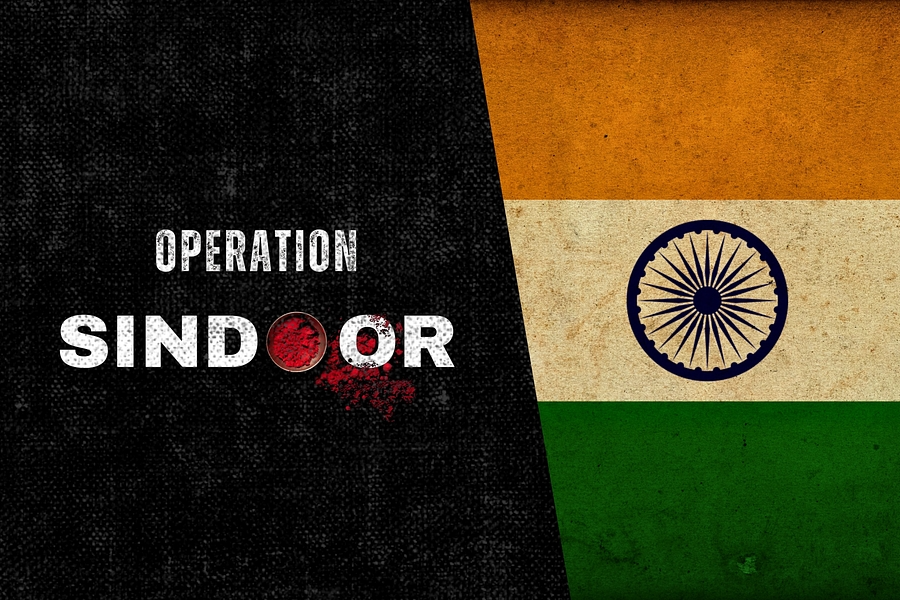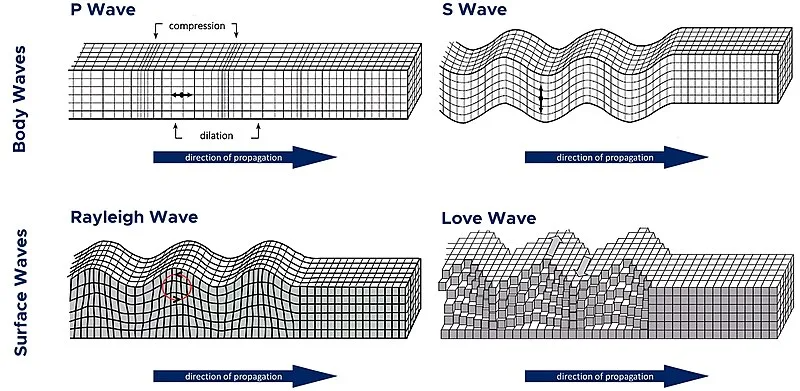October 04th Current Affairs
Table of Contents
Kannada Literature Optional Syllabus
Home / ಐಚ್ಚಿಕ ಕನ್ನಡ ಸಾಹಿತ್ಯದ ಪಠ್ಯಕ್ರಮ ಐಚ್ಚಿಕ ಕನ್ನಡ ಸಾಹಿತ್ಯ ಪತ್ರಿಕೆ – 1 ವಿಭಾಗ – ಎ ಅ) ಕನ್ನಡ ಭಾಷೆಯ ಚರಿತ್ರೆ ಭಾಷೆ
UPSC Current Affairs – October 6th
October 06th Current Affairs Home / Table of Contents 36-hour curfew imposed in parts of Odisha’s Cuttack over communal tensions
Religious Minorities in India and the Challenge of Communal Harmony: A Sociological Reflection on the Cuttack Violence
Home / Religious Minorities in India and the Challenge of Communal Harmony: A Sociological Reflection on the Cuttack Violence Sociology
UPSC Current Affairs – October 4th
October 04th Current Affairs Home / Table of Contents Isabgol Processors threaten to halt purchases from October 6th over GST
Sologamy and Contemporary Trends in Marriage: A Sociological Perspective
Home / Sologamy and Contemporary Trends in Marriage: A Sociological Perspective Sociology Paper 1: Systems of Kinship – Contemporary trends
UPSC Current Affairs – October 3rd
October 03rd Current Affairs Home / Table of Contents NASA IMAP to show how solar particles are energised and shield
Understanding Indian Festivals through Durkheim: Religion, Rituals, and Collective Conscience
Home / Understanding Indian Festivals through Durkheim: Religion, Rituals, and Collective Conscience Sociology Paper 1: Émile Durkheim – Religion and
UPSC Current Affairs – September 30th
September 30th Current Affairs Home / Table of Contents Ladakh groups reject talks with government, Ministry says open to dialogue
Caste Census in India: A Sociological Perspective
Home / Caste Census in India: A Sociological Perspective Sociology Paper 2: Caste System – Features of Caste system. The
Constitutional Morality: Upholding India’s Democratic Ethos
Home / Constitutional Morality: Upholding India’s Democratic Ethos Sociology Paper 2: Visions of Social Change in India – Constitution, law,
Isabgol Processors threaten to halt purchases from October 6th over GST Issues

Relevance to UPSC
Paper II: Governance / Policy Implementation
Regulatory and Policy Clarity. Reflects issues of bureaucratic ambiguity and the need for transparent, consultative governance between industry and government to ensure smooth implementation of taxation reforms.
Government–Industry Interface.Showcases the importance of institutional dialogue and grievance redressal in maintaining economic stability and safeguarding livelihoods affected by policy uncertainty.
Paper III: Economy, Taxation & Agriculture
GST and Agricultural Value Chains. The issue highlights challenges in GST classification and its cascading impact on agricultural processing industries, particularly Isabgol (psyllium husk) processors who face financial strain due to unclear tax treatment.
Impact on Farmers and Exports. Demonstrates how tax policy uncertainty can disrupt farm-to-market linkages, stall procurement from farmers, and affect India’s export competitiveness in agro-based sectors.
More About the News
- Isabgol (psyllium) processors have warned they will stop buying seeds/purchases from farmers starting October 6 due to ambiguities in how GST is applied to psyllium/seed.
- The industry claims that unclear classification forces them to pay GST on seeds (without assured refunds), straining their capital and hurting exports.
- This strike threat could disrupt the supply chain for isabgol products used in food, health products, and exports, impacting farmers in producing states like Gujarat and Rajasthan.
GST Bachat Utsav (GST 2.0)
Introduced in 2017, India’s GST unified multiple taxes into a single framework. GST 2.0 further simplifies compliance, rationalizes rates, and addresses inverted duty structures, aiming to boost consumption, support businesses, and enhance economic efficiency.
Background
- GST, India’s unified indirect tax system, was launched in July 2017 and has undergone multiple revisions.
- The latest reform, effective 22 September 2025, is termed “GST Bachat Utsav” by the Prime Minister.
- Aims: Simplify tax slabs, resolve classification disputes, correct inverted duty structures (IDS), and boost household consumption.
Key Features of GST 2.0
- Rate Rationalisation:
- Transition from 4-slab system (5%, 12%, 18%, 28%) to 2 main slabs:
- Merit rate: 5% – covers 516 items, mostly food items, agricultural machinery, and medical devices.
- Standard rate: 18% – covers 640 items, mainly industrial goods, small cars, and bikes.
- Special slabs:
- 0.25% – rough diamonds, semi-precious stones
- 1.5% – cut and polished diamonds
- 3% – precious metals like gold, silver, pearls
- 40% – sin/demerit goods like pan masala, tobacco, aerated drinks, yachts, luxury cars
- 12% slab abolished, except for bricks (retained under special composition scheme)
- Transition from 4-slab system (5%, 12%, 18%, 28%) to 2 main slabs:
- Services Covered / Rate Cuts:
- Life & health insurance: Exempted (was 18%)
- Hotels ≤ Rs 7,500/day: GST reduced to 5% without ITC (earlier 12% with ITC)
- Salons, spas, wellness services: GST reduced from 18% → 5%
- Passing Benefits to Consumers:
- Field officers will compile monthly reports on price changes post-GST rationalisation.
- Ministry of Finance will monitor for six months to ensure benefits reach consumers.
Economic Rationale
- Boost to Household Consumption:
- Lower GST rates increase disposable income and incentivize consumption and investments.
- Government expects higher consumption to offset revenue loss from rate cuts on 375+ items.
- Correcting Inverted Duty Structure (IDS):
- IDS arises when input tax > output tax, blocking capital.
- Example: Textile fabric taxed at 12% (input) vs finished garment at 5% (output).
- GST 2.0 aligns inputs and outputs in the same slab to relieve IDS.
Implementation and Compliance Reforms
- Simplified registration: More tech-driven and time-bound
- Pre-filled returns: Minimises manual errors and mismatches
- Automated refund processes: For exporters and IDS cases
- Amendment to CGST Act 2017 (Section 54(6)): Allows 90% provisional refund for IDS cases, similar to zero-rated supplies
Challenges
- Revenue concerns: Potential losses for Centre & States despite expected boost in consumption
- Residual IDS issues: Persist in bicycles, tractors, fertilisers, textiles, corrugated boxes
- Enforcement gap: No strong legal mechanism to prevent profiteering, currently reliant on monitoringa
Way Forward
- Address residual IDS issues and ensure benefits are passed to consumers through stricter anti-profiteering
- Strengthen state finances via improved compliance and digital monitoring
- Conduct periodic slab reviews to maintain balance between revenue neutrality and ease of doing business
- Promote trust-based compliance through sustained tech-enabled registration, return filing, and refund mechanisms
Future GST reforms should strengthen digital compliance, resolve residual inverted duty issues, and ensure anti-profiteering measures. A responsive GST system can promote equitable taxation, stimulate consumption, and support sustainable economic growth and fiscal stability in India.
Prelims MCQ
Q. Consider the following statements regarding GST 2.0 reforms in India: 1. GST 2.0 has reduced the number of main tax slabs from four to two. 2. Life and health insurance services are fully exempted under GST 2.0. 3. The 12% slab has been completely abolished with no exceptions. Which of the above statements is/are correct?
A. 1 only
B. 1 and 2 only
C. 1 and 3 only
D. 1, 2, and 3
Mains Question
Q. GST 2.0 reforms represent a significant step towards simplifying India’s indirect taxation while addressing inverted duty structures and boosting household consumption. Critically analyse the economic rationale, implementation challenges, and potential impact of these reforms on consumers, businesses, and state finances.
India eyes Trade Secret Laws to plug big IP Gap

Relevance to UPSC
General Studies Paper III: Economy, Innovation & Intellectual Property Rights (IPR)
- The issue pertains to strengthening India’s legal framework for trade secrets, addressing gaps in intellectual property law, and protecting unpatented innovations.
More About the News
- India is considering a standalone trade secrets law to fill a major gap in its IP framework, since currently protection relies mainly on contract law and common law precedents.
- The new legislation would formalize protection for confidential business information like formulas, designs, and processes, boosting investor confidence and encouraging innovation.
- It aims to align India’s IP regime with global norms, improve legal clarity, and better support industries (especially tech, manufacturing, R&D) in protecting proprietary assets.
Intellectual Property Rights (IPR)
Intellectual Property Rights (IPR) protect creations of the human mind, ranging from inventions and literary works to designs and trade secrets. They incentivize innovation, promote economic growth, and safeguard cultural and technological advancements. By balancing creators’ rights with public interest, IPR fosters a knowledge-driven economy.
Overview
- Intellectual Property (IP) refers to creations of the human mind in arts, science, literature, technology, and other fields.
- IPR grants legal protection to creators, balancing innovators’ interests with public good.
- Objectives include financial reward, promotion of innovation, and protection of traditional knowledge.
Types of Intellectual Property Rights
- Patent:
- Granted for inventions satisfying novelty, non-obviousness, and industrial application.
- Covers both products and processes.
- Provides exclusive rights while requiring public disclosure of the invention.
- Copyright:
- Protects authors’ and artists’ creative works: books, music, films, software, maps, advertisements.
- Duration: At least 50 years after the author’s death.
- Related rights cover performers, phonogram producers, and broadcasting organizations.
- Trademarks:
- Identifies and distinguishes goods/services of one business from another.
- Historically, artisans marked their products to claim ownership.
- Industrial Designs:
- Protects the decorative or aesthetic aspects of objects (2D patterns/colors or 3D shapes).
- Protects the decorative or aesthetic aspects of objects (2D patterns/colors or 3D shapes).
- Geographical Indications (GI):
- Labels products tied to a specific geographic origin with unique qualities.
- Often includes the location name in the product label.
- Trade Secrets:
- Protects confidential business information, e.g., formulas, processes, or strategies.
- Unauthorized use or disclosure is considered unfair practice.
International Bodies & Conventions
- WIPO: Oversees global IP protection and treaties:
- Paris Convention (1883): Industrial property protection, national treatment.
- Berne Convention (1886): Protects literary and artistic works.
- Budapest Treaty: Recognizes deposits of microorganisms for patents.
- Marrakesh Treaty: Facilitates accessible books for visually impaired.
- Patent Cooperation Treaty (1970): Standardized process for international patent filing.
- TRIPS Agreement (1994, WTO):
- Covers copyrights, trademarks, GI, industrial designs, patents, integrated circuits, trade secrets.
- Ensures standards, enforcement, and dispute settlement among members.
Intellectual Property Rights in India
- India committed to IPR through TRIPS and WIPO membership.
- KAPILA Program: Promotes IP literacy in higher education institutions.
- Legal Framework:
- Patents Act, 1970 (amended 2005)
- Designs Act, 2000
- Trademarks Act, 1999 (amended 2010)
- Geographical Indications of Goods Act, 1999
- CIPAM: Cell under DPIIT for implementing National IPR Policy 2016, promoting awareness, commercialization, and enforcement.
- National IPR Policy 2016: Unified framework, traditional knowledge protection, global best practices adaptation.
Advantages of IPR
- Encourages creation, innovation, and dissemination of new products/services.
- Economic growth: Generates revenue through commercialization and licensing.
- Cultural development: Supports creative industries like publishing, music, films.
- Knowledge sharing: Patents provide technical information for public use.
- Fair competition: Ensures informed consumer choice and market fairness.
- R&D promotion: Financial incentives encourage development of new technologies.
- Financing support: Intangible assets like patents help SMEs secure loans or investments.
Disadvantages of IPR
- High costs for registration and maintenance.
- Risk of piracy despite protection.
- Quality of IP may decline over time.
- International disparities can limit access for developing nations.
- Patented products, e.g., medicines, may be expensive, affecting public access.
Issues in India’s IPR Regime
- Evergreening Restrictions (Section 3(d)):
- Section 3(d) of the Indian Patent Act, 1970 (amended 2005) prohibits patents for new forms of known substances unless they show significant improvement in efficacy.
- This prevents patent evergreening, limiting repeated minor patents.
- Example: Indian Patent Office rejected Novartis’ patent for Glivec (imatinib mesylate).
- Concern: Pharmaceutical companies argue it limits incentives for innovation.
- Compulsory Licensing (CL):
- CL allows the government to authorize production, sale, import, or use of a patented invention without the patent holder’s consent.
- Indian Patents Act permits CL under conditions of public health emergencies, extreme urgency, or anti-competitive practices.
- Challenge: Foreign investors worry about misuse of CL, impacting FDI and negotiations like India-EU FTA.
- Compliance: CL aligns with WTO TRIPS provisions.
- US Trade Concerns:
- India is on the USTR’s ‘Priority Watch List’ for alleged IPR violations.
- Criticism: India is considered a challenging economy for IP protection and enforcement.
- Data Exclusivity Issues:
- Foreign MNCs argue Indian law does not protect against unfair commercial use of test or clinical trial data submitted for market approval.
- Demand: Introduction of a Data Exclusivity law for pharma and agro-chemical products.
- Weak Enforcement of Copyright:
- Piracy of copyrighted materials remains widespread.
- Enforcement gaps reduce confidence in IP protection for creators.
Way Forward
- Promote innovation culture from school level; revamp academic curricula to include IP awareness.
- Establish effective mechanisms to resolve IPR disputes and legal issues.
- Strengthen IP laws and regulations to fully leverage benefits of a robust IPR system.
- Support flagship programs like Make in India and Startup India through stronger IP safeguards.
- Increase awareness among industry and entrepreneurs about creation, protection, and enforcement of IPR to encourage innovation.
Going forward, India must strengthen its IPR framework through robust enforcement, awareness programs, and alignment with global standards. Encouraging innovation in startups, academia, and industry will boost economic competitiveness. A dynamic and balanced IPR system can drive sustainable development, technology transfer, and global collaboration.
Prelims MCQ
Q. Which of the following statements regarding India’s Intellectual Property Rights (IPR) framework is/are correct? 1. Section 3(d) of the Indian Patent Act prevents evergreening of patents. 2. Compulsory licensing is permitted under Indian law only for national emergencies, extreme urgency, or anti-competitive practices. 3. India’s IPR framework is fully compliant with data exclusivity requirements under the TRIPS agreement.
A. 1 and 2 only
B. 2 and 3 only
C. 1 and 3 only
D. All of the above
Mains Question
Q. Intellectual Property Rights (IPR) are crucial for fostering innovation and economic growth in India, yet challenges such as evergreening, compulsory licensing, and weak enforcement persist. Critically examine India’s IPR framework and suggest reforms to strengthen innovation, industry competitiveness, and global compliance.
No cough syrup for children under 2, Centre warns after deaths in 2 states
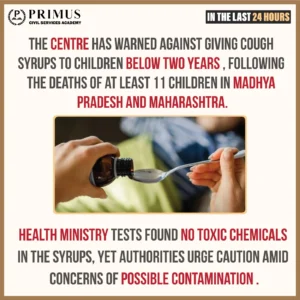
Relevance to UPSC
General Studies Paper II – Governance & Social Justice
- Public Health Policy and Regulation. The incident underscores the need for stringent regulatory oversight and clear guidelines in public health policies, especially concerning pediatric medications.
- Role of Government in Public Health. Highlights the government’s responsibility in ensuring the safety and efficacy of medicines, and in issuing timely advisories to protect vulnerable populations.
- Inter-Departmental Coordination. Demonstrates the importance of coordination between health authorities, regulatory bodies, and state governments in addressing public health emergencies
More About the News
- 11 children have died in Madhya Pradesh and Maharashtra due to suspected kidney failure linked to cough syrup consumption.
- The Directorate General of Health Services (DGHS) has issued an advisory cautioning against the use of cough syrups in children under 2 years.
- Despite initial concerns, the Union Health Ministry’s testing found no toxic chemicals in the cough syrup samples.
Healthcare in India
Health care forms the backbone of a nation’s development, encompassing preventive, promotive, curative, and rehabilitative services. India’s health system is evolving with initiatives like Ayushman Bharat and Health & Wellness Centres to improve access and quality. Strengthening primary care and integrating digital health are central to ensuring equitable and efficient healthcare delivery.
Important Statistics
- Healthcare Centres Network: India has 1,69,615 Sub-Centres (SCs), 31,882 Primary Health Centres (PHCs), and 6,359 Community Health Centres (CHCs) catering to urban and rural populations.
- Healthcare Standards: Only 3.4% of SCs and 13% of PHCs meet Indian Public Health Standards (IPHS).
- Health and Wellness Centres (HWCs): 1.6 lakh+ HWCs deliver comprehensive services, including maternal and child health and non-communicable disease (NCD) care.
- Doctor-Population Ratio: Currently 1:834, surpassing WHO benchmark of 1:1000, reflecting improved healthcare access.
- Healthcare Spending: India invests 2.1% of GDP in health, emphasizing primary care through schemes like Ayushman Bharat.
Indian Healthcare System Structure
- The Indian healthcare system is broadly divided into Primary, Secondary, and Tertiary levels, each catering to progressively advanced healthcare needs.
Primary Healthcare System
- Role: Forms the foundation of India’s medical network, focusing on prevention, early detection, basic treatment, and health awareness.
- Key Components:
- Health education and awareness campaigns.
- National immunisation programs.
- Maternal and child healthcare support.
- Basic treatment and control of common diseases.
- Sanitation, nutrition, and hygiene promotion.
- Infrastructure:
- Sub-Centres (SCs): Staffed by Auxiliary Nurse Midwives (ANMs), serving rural populations.
- Primary Health Centres (PHCs): First formal point for professional care, offering promotive, preventive, and curative services.
Secondary Healthcare System
- Role: Provides specialist care and advanced treatment for patients referred from primary centres.
- Key Components:
- District Hospitals and Community Health Centres (CHCs).
- Specialist services in gynecology, pediatrics, internal medicine, and surgery.
- Emergency services and minor surgical procedures.
- Infrastructure:
- CHCs: Act as a link between PHCs and tertiary care institutions.
- District Hospitals: Offer comprehensive medical facilities for larger communities.
Tertiary Healthcare System
- Role: Provides highly specialized, advanced medical treatment using cutting-edge technology.
- Key Components:
- Super-specialty hospitals for organ transplants, cancer care, neurosurgery, etc.
- Teaching hospitals linked to medical colleges and research bodies.
- Private hospitals contribute significantly in urban areas with specialized services.
- Infrastructure:
- Premier institutes like AIIMS and other centres of excellence.
- Corporate hospitals equipped with global-level medical infrastructure.
Changing Nature of Health Care
- Evolving Public Health Landscape: Urbanization, lifestyle changes, and economic growth necessitate updated health strategies.
- Rise of NCDs: Diabetes, cardiovascular diseases, and cancers account for over 60% of global deaths; projected to rise by 17% in the next decade (WHO).
- Antimicrobial Resistance (AMR): Overuse of antibiotics threatens treatment effectiveness and increases healthcare costs.
- Mental and Zoonotic Health Threats: Mental health disorders are increasing; zoonotic diseases like COVID-19 highlight the need for integrated systems.
- Need for Holistic Approach: Public health requires considering environmental conditions, social determinants, and individual health behaviours.
Key Concerns in Primary Health Care
- Inadequate Infrastructure: Only 30% of PHCs have all required facilities (Rural Health Statistics).
- Shortage of Human Resources: Over 65% of CHC specialist posts vacant; shortages of doctors, nurses, and lab technicians persist.
- High Out-of-Pocket Expenditure (OOP): >48% of health expenditure borne by individuals, often causing catastrophic spending.
- Limited Rural Access: 8% of SCs and PHCs in remote areas with poor connectivity, affecting tribal and hilly populations.
- Overburdened Facilities: PHCs often serve populations exceeding recommended norms (1 PHC per 30,000; 20,000 in tribal areas).
- Fragmented Care: Preventive, promotive, and curative services are not fully integrated; mental health available in <20% of primary care facilities.
Government Initiatives for Health Care
- Ayushman Bharat – HWCs: Provides preventive, curative, and palliative care across 150,000 SCs and PHCs.
- National Health Mission (NHM): Strengthens infrastructure and accessibility, focusing on maternal and child health, immunization, and disease control.
- PM-Ayushman Bharat Health Infrastructure Mission (PM-ABHIM): Upgrades health infrastructure via Block Public Health Units and district systems.
- Indian Public Health Standards (IPHS): Standardizes quality and service norms across primary healthcare.
- National Digital Health Mission (NDHM): Digitizes health records, improving efficiency and accessibility.
- Jan Aushadhi Scheme: Provides affordable generic medicines via Jan Aushadhi Kendras, especially for rural populations.
Best Practices
Cuba: Focus on Primary Healthcare
Emphasizes preventive care and a robust primary healthcare system.
Doctors are placed within communities to ensure early detection and timely intervention.
Lesson for India: Strengthen Primary Health Centres (PHCs) and expand preventive services to manage health issues before they escalate.
Estonia: Digital Health Integration
Offers universal electronic health records enabling seamless healthcare delivery.
Lesson for India: Scale up digital health platforms to integrate electronic health records across all levels of healthcare services.
Way Forward
- Strengthen Health Infrastructure: Upgrade SCs, PHCs, and CHCs with essential facilities and medicine supply.
- Integrate Preventive and Holistic Care: Expand HWCs to include mental health, NCD management, and lifestyle services.
- Promote Digital Health Solutions: Implement NDHM, telemedicine, and better health record management.
- Enhance Community Engagement: Leverage ASHAs and Village Health Committees for awareness and service uptake.
- Encourage Public-Private Partnerships: Collaborate with NGOs and private sector to improve delivery and innovation.
- Increase Financing and Governance: Raise public health spending to 2.5% of GDP with transparent governance.
- Improve Quality and Accountability: Regular audits and patient feedback to maintain IPHS and National Quality Assurance Standards (NQAS).
Moving forward, India must enhance healthcare infrastructure, integrate preventive and digital solutions, and expand skilled human resources to meet rising demands. Promoting public-private partnerships and community engagement will ensure comprehensive care. A resilient, inclusive, and technology-enabled health system can safeguard population health and drive sustainable development.
Prelims MCQ
Q. Consider the following statements regarding India’s primary healthcare system:
1. Health and Wellness Centres (HWCs) under Ayushman Bharat provide only curative services.
2. India’s doctor-population ratio currently exceeds the WHO recommended standard of 1:1000.
3. Non-Communicable Diseases (NCDs) account for more than half of India’s disease burden.
Which of the statements given above is/are correct?
A. 1 and 2 only
B. 2 and 3 only
C. 1 and 3 only
D. 1, 2, and 3
HWCs provide comprehensive care, including preventive, promotive, curative, and palliative services, so statement 1 is incorrect. India’s doctor-population ratio is 1:834, exceeding WHO norms. NCDs contribute to over 60% of the disease burden, validating statement 3.
Mains Question
Q. Critically examine the challenges faced by India’s primary healthcare system in providing equitable access and quality care. Suggest policy measures and technological innovations that can strengthen the system and improve health outcomes, particularly in rural and remote areas.
Marginalised groups under attack in Pakistan, Bangladesh: India
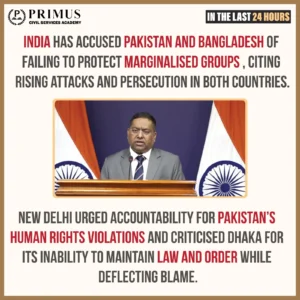
Relevance to UPSC
General Studies Paper II – Governance,Social Justice and International Relations
- Human Rights: The article discusses human rights violations in Pakistan-occupied Kashmir (PoK), highlighting issues related to freedom of expression, political participation, and state repression.
International Relations: India’s Ministry of External Affairs (MEA) has condemned Pakistan’s actions in PoK, emphasizing the need for accountability and raising concerns over the treatment of civilians.
More about the News
- Massive protests have erupted in PoK, demanding political reforms and an end to systemic oppression by Pakistani authorities.
- The Indian government has condemned the human rights violations in PoK, calling for Pakistan to be held accountable.
- Pakistan has deployed additional security forces and imposed restrictions to quell the protests, leading to heightened tensions in the region.
Human Rights
Human rights are inherent, universal entitlements that safeguard the dignity, liberty, and equality of every individual. They form the foundation of democratic governance and social justice, bridging moral, legal, and humanitarian obligations. Globally codified through instruments like the UDHR and domestically through the Constitution of India, they ensure protection against discrimination and abuse.
Overview
- Human rights are inherent rights all humans possess by virtue of being human, regardless of nationality, sex, race, religion, or language.
- They range from fundamental rights like the right to life to socioeconomic rights including food, education, health, work, and liberty.
- World Human Rights Day is observed on 10th December, commemorating the 1948 adoption of the Universal Declaration of Human Rights (UDHR) by the UN General Assembly.
- The UN Office of the High Commissioner for Human Rights (OHCHR), headquartered in Geneva, leads global promotion and protection of human rights.
International Bill of Human Rights
- Post-WWII, universal human rights were codified internationally.
- UDHR (1948): 30 articles outlining fundamental principles forming the foundation of human rights law.
- International Covenants (1966):
- ICESCR – Economic, Social, Cultural Rights (monitored by Committee on Economic, Social and Cultural Rights).
- ICCPR – Civil and Political Rights (monitored by Human Rights Committee).
- Together, UDHR + ICESCR + ICCPR = International Bill of Human Rights.
Other International Human Rights Treaties
- International humanitarian law complements human rights in conflict.
- Key treaties include:
- Genocide Convention (1948)
- CERD – Racial Discrimination (1965)
- CEDAW – Women’s Rights (1979)
- Convention against Torture (1984)
- CRC – Children’s Rights (1989)
- Convention on Migrant Workers (1999)
- Convention on Enforced Disappearance (2006)
- Convention on Persons with Disabilities (2006)
- UN Guiding Principles on Business & Human Rights (2011) set corporate responsibility standards.
Human Rights in India
- Definition: Rights related to life, liberty, equality, and dignity, guaranteed by the Constitution and enforceable in courts.
- National Human Rights Commission (NHRC): Established in 1993 under the Protection of Human Rights Act, 1993; State Human Rights Commissions also exist.
- Constitutional Provisions:
- Fundamental Rights (Articles 14–32): Right to equality (14–18), freedom of speech (19), right to life and liberty (21).
- Directive Principles of State Policy (Articles 36–51).
- Enforcement through Supreme Court (Art. 32) and High Courts (Art. 226).
- India is a signatory to UDHR, ICESCR, ICCPR, CEDAW, CRC, CRPD, and other conventions.
- Other domestic protections include: Forest Rights Act, Land Acquisition Act, Street Vendors Act, Jan Dhan Accounts, Ujjwala, PM Awaas, Triple Talaq Act, National Portal for Transgender Persons.
Emerging Challenges
- State or institutional violations: e.g., Holocaust, genocide, discrimination.
- Right to live with dignity: Manual scavenging, displacement of tribals, environmental pollution.
- Women’s rights violations: Violence at home, workplace, or under oppressive regimes.
- Prisoners’ rights: Custodial torture, forced labor, poor conditions; Supreme Court vigilance noted.
- Corruption: Undermines rule of law, democracy, and social justice.
- Misuse of anti-terror laws against minorities or political opponents.
Importance of Human Rights
- Protect individuals from abuse and discrimination.
- Ensure equal opportunities for physical and intellectual growth.
- Promote freedom of speech, religious freedom, and government accountability.
- Ensure access to basic needs and societal justice.
Way Forward
- Timely and effective service delivery: Improve administration and monitoring to reduce violations caused by corruption.
- Focus on underdeveloped nations: Support vulnerable countries in sustaining human rights measures.
- Strengthen NHRC: Make recommendations legally binding and enhance coordination with state bodies.
- Update laws: Align older provisions with contemporary human rights needs.
- Community and state cooperation: Essential for improving and safeguarding human rights in India.
Strengthening human rights frameworks requires timely enforcement, legal reforms, and increased awareness at all levels of society. Emphasizing technological solutions, transparency, and accountability can mitigate violations. A proactive, inclusive approach will reinforce India’s democratic ethos, uphold international commitments, and promote equitable development.
Prelims MCQ
Q.
Other than the Fundamental Rights, which of the following parts of the Constitution of India reflect the principles and provisions of the Universal Declaration of Human Rights (1948)? (PYQ 2020)
1. Preamble
2. Directive Principles of State Policy
3. Fundamental Duties
Select the correct answer using the code given below:
A. 1 and 2 only
B. 2 only
C. 1 and 3 only
D. 1, 2 and 3
The Preamble embodies human rights ideals like liberty, equality, and dignity. The Directive Principles promote social and economic rights, reflecting UDHR provisions. Fundamental Duties reinforce respect for human rights, ensuring individual and collective responsibilities.
Mains Question
Q. Despite constitutional safeguards and international commitments, India continues to face challenges in ensuring effective human rights protection. Examine the structural, legal, and socio-economic factors impeding human rights enforcement in India, and suggest comprehensive measures to enhance their protection and promotion
US shutdown drags on as funding vote fails again, hopes for quick deal fade
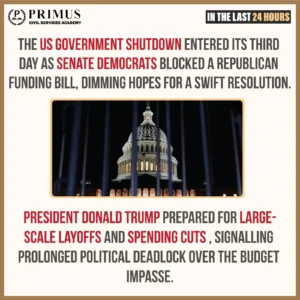
Relevance to UPSC
General Studies Paper II – Governance & Social Justice
- Federalism and Autonomy. Centre-State Relations and how this relation shapes a policy.
- Role of Government in Public Health. How does the State impact a system through its presence by taking an active part in delivery of Services or regulation of the industry or by giving free will to the market.
More about the News
- The U.S. government shutdown entered its third day on October 3, 2025, after the Senate failed to advance a Republican-backed funding bill.
- Democrats are demanding the extension of pandemic-era healthcare subsidies, while Republicans are pushing for spending cuts and federal layoffs.
- President Trump has frozen $2.1 billion in infrastructure funding for Chicago, targeting Democratic-controlled cities amid the shutdown.
Centre-State Relations
Centre-State relations form the backbone of India’s federal structure, ensuring a balance of power between the Union and State governments. They govern legislative, administrative, and financial interactions, aiming to maintain national unity while respecting regional autonomy. Effective relations are essential for smooth governance and socio-economic development.
Centre-State Relations in India
Three Dimensions:
- Legislative Relations: Division of law-making powers between Centre and States.
- Administrative Relations: Allocation of responsibilities for governance and policy implementation.
- Financial Relations: Distribution of resources, taxation powers, and fiscal devolution.
1. Legislative Relations
Articles 245–255: Territorial Extent & Legislative Powers:
- Article 245: Parliament can legislate for all or any part of India, including Union Territories; States legislate for their own territories.
- Article 246: Division of subjects via Seventh Schedule; in conflicts, Union law prevails (Article 254).
- Articles 247–255:
- Article 247: Parliament can create additional courts.
- Article 248: Residuary powers to Parliament.
- Article 249: Parliament can legislate on State List with Rajya Sabha 2/3 majority.
- Article 250: Parliament can legislate during National Emergency on State List subjects.
- Article 252: States can request Parliament to legislate on a State List subject.
Seventh Schedule: Legislative Subjects
- Union List: Parliament only – Defense, Foreign Affairs, Railways, Atomic Energy, Banking.
- State List: State Legislatures only – Police, Public Health, Land, Agriculture, Liquor.
- Concurrent List: Both – Criminal Law, Education, Marriage, Forests; Union law prevails in conflict (Article 254).
Conditions for Centre’s Legislative Power on State Subjects:
- Article 249: Rajya Sabha resolution (e.g., POTA 2002).
- Article 250: National Emergency (Article 352).
- Article 252: Request by two or more States (e.g., Water Pollution Act 1974).
- Article 253: Implementing international treaties (e.g., Environment Protection Act 1986).
- Article 356: President’s Rule – Centre assumes legislative powers if State machinery fails.
Centre’s Control Over State Legislation:
- Governor’s Role: Can withhold or reserve bills for President’s assent (Articles 200–201).
- President’s Rule: Dissolution of State Assembly and direct central legislation (e.g., Maharashtra 2019).
2. Administrative Relations
Articles 256–263: Executive Powers Distribution
- Article 256: States must comply with Union laws; Centre can issue directives.
- Article 257: Centre supervises State executive powers, especially on national security and infrastructure.
- Articles 258–258A: Delegation of executive powers between Centre and States.
- Articles 261–263: Inter-state coordination; recognition of public acts, water dispute resolution, Inter-State Council formation.
Centre’s Directions (Articles 256 & 257):
- Compliance with Union laws, national interest, and SC/ST protection.
- Non-compliance can lead to President’s Rule (e.g., Punjab 1987, J&K 2018).
Integrated Judicial System & Law Enforcement:
- Single judiciary with hierarchical authority – Supreme Court (Article 141) binding all courts.
- All-India Services (IAS, IPS, IFoS) ensure administrative unity.
- Central agencies (CBI, NIA, ED) can override State law enforcement in certain cases.
National Emergency (Article 352) places law and order under Centre.
3. Financial Relations
Articles 268–293: Taxing Powers & Fiscal Federalism
- Article 268: Duties levied by Centre but collected by States (e.g., stamp duty, excise on medicines).
- Article 269: Taxes assigned to States (pre-GST).
- Article 270: Shared taxes between Centre and States (e.g., income tax).
- Article 271: Centre can levy surcharges; not shared with States.
- Article 272: Abolished post-GST.
Revenue Sources:
- Centre: Direct taxes, CGST/IGST, customs, PSUs dividends.
- States: SGST, state excise, property tax, land revenue, non-tax revenue.
GST & Financial Coordination:
- Dual GST system (CGST & SGST); IGST shared based on consumption.
- GST Council ensures Centre-State cooperation.
Grants-in-Aid:
- Statutory (Article 275): Recommended by Finance Commission to bridge fiscal gaps.
- Discretionary (Article 282): Provided at Centre’s discretion for emergencies or special projects.
- Finance Commission (Article 280): Reviews tax-sharing, recommends grants (15th FC: 41% devolution).
Challenges in Centre-State Relations:
- Fiscal Imbalances:
- Delayed GST compensation; unequal resource allocation; surcharge/cess issues.
- Example: Punjab, Kerala, West Bengal (2020).
- Legislative Conflicts & Central Overreach:
- Use of Articles 249 & 252; central laws on State subjects; concurrent list disputes.
- Example: 2020 Farm Laws conflict with Punjab & Chhattisgarh.
- Misuse of Article 356:
- Political motivations; judicial safeguards post S.R. Bommai case (1994).
- Example: Uttarakhand 2016.
- Role of Governors:
- Alleged bias, delaying assent, interference in government formation.
- Example: Maharashtra 2019 political crisis.
- NITI Aayog vs Planning Commission:
- NITI Aayog promotes cooperation but lacks financial allocation power; States feel limited in decision-making.
- Example: Andhra Pradesh Special Category Status dispute (2018).
- Law Enforcement & Investigations:
- CBI, NIA, ED intervention causing friction with States.
- Example: Maharashtra withdrawing general consent for CBI investigations (2020).
- Inter-State Water Disputes:
- Delayed tribunal verdicts; Centre accused of favoring politically aligned States.
- Example: Cauvery River dispute, Karnataka vs Tamil Nadu.
Recommendations to Ensure Harmonious Centre-State Relations
Sarkaria Commission (1983):
- Strengthen the institution of All-India Services and consider creating more such services.
- Union government should intervene in Concurrent List subjects only where uniformity of policy is essential, leaving the rest for State action.
M.M. Punchhi Commission (2007):
- Constitutionally define the devolution of powers to local bodies as institutions of self-government.
- Recommend a fixed five-year tenure for Governors; removal only through impeachment by State Assembly, similar to President’s removal by Parliament.
National Commission to Review the Working of the Constitution (NCRWC, 2000):
- Establish an Inter-State Trade and Commerce Commission under Article 307 as a legislative body.
- Include emergency and disaster management in the Concurrent List of the Seventh Schedule.
Way Forward
- Strengthen cooperative federalism through regular consultations between the Centre and States.
- Ensure timely and transparent devolution of funds recommended by the Finance Commission.
- Clearly define legislative and administrative domains to prevent conflicts over Centre-State powers.
- Promote fixed tenures for Governors and limit discretionary powers to reduce political interference.
- Encourage decentralization by empowering local bodies for effective grassroots governance.
- Institutionalize inter-state councils and mechanisms for dispute resolution on contentious issues.
- Leverage technology and data-sharing for coordinated policy implementation and monitoring.
A harmonious Centre-State relationship is pivotal for strengthening cooperative federalism and accelerating India’s development. Future governance must focus on clarity of powers, equitable resource sharing, and collaborative policymaking to address regional aspirations and national priorities.
Way Forward
- Strengthen intelligence-sharing and inter-agency coordination.
- Leverage technology, AI, and cyber surveillance for monitoring criminal networks.
- Reform laws to ensure fast-track prosecution and stronger deterrence.
- Promote public awareness and community policing.
- Enhance international cooperation and extradition mechanisms.
Organised crime continues to evolve with technology and globalisation, posing serious threats to security, economy, and social stability. Future strategies must combine robust legal frameworks, intelligence-based enforcement, and international cooperation. Strengthening governance and community resilience will be critical to mitigating the impact of organised crime globally.
Prelims MCQ
Q. Which of the following statements regarding Centre-State relations in India is/are correct?
1. Parliament can legislate on a State List subject during a National Emergency.
2. Governors can withhold assent to a State Bill and reserve it for the President’s approval.
3. The Finance Commission recommends devolution of taxes and grants to States.
Select the correct answer using the code below:
A. 1 and 2 only
B. 2 and 3 only
C. 1 and 3 only
D. All of the above
All three statements are correct. Article 250 allows Parliament to legislate on State List subjects during National Emergency. Article 200 permits Governors to reserve State Bills for Presidential assent. Article 280 mandates the Finance Commission to recommend tax devolution and grants.
.Mains Question
Q. Examine the key challenges in India’s Centre-State relations, with special reference to legislative, administrative, and financial dimensions. Suggest measures to strengthen cooperative federalism while balancing national interests and regional autonomy.



